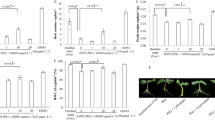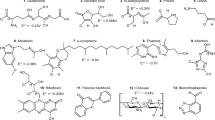Abstract
To assess the protective effects of diphenylamine (DPA) on yield, DPA- and non-DPA-treated plants of potatoes (Solanum tuberosum cv. Agria) were exposed to ambient air at a rural site in Spain. Concentrations of ambient ozone were high at the site. Untreated plants served as controls. The DPA treatments did not have a significant effect on Chl content. The treatment with DPA (0.2 M) caused a significant increase of fresh weight production and tuber number of the potato plants in both years of study (32 and 47% in 2002 and 9 and 27% in 2003). Changes in the activity of antioxidant enzymes guaiacol peroxidase (GPX) and glutathione reductase (GR) in the leaves were determined in control and DPA-treated plants. The GPX activity in the leaves was significantly lower in the treated plants. GR was also lower, but not significantly, in the treated plants. The highest correlation between enzyme activity and yield was found in the case of GPX. The protective effect of DPA was related inversely to peroxidase activity. This is the first report demonstrating markedly enhanced yield and reduction of peroxides of potentially harmful O3 by DPA as a mechanism for protecting plants against noxious oxidative stress from the environment.
Similar content being viewed by others
References
Alfonssi, D., Sandroni, S. and Viarengo, S.: 1991, ‘Tropospheric ozone in the 19th century: The Moncalliere series’, J. Geophys. Res. 96D, 17349–17352.
Astorino, G., Margani, I., Tripodo, P. and Manes, F.: 1995, ‘The response of Phaseolus vulgaris L. cv Lit to different dosage of the antiozonant ethylenediurea (EDU) in relation to chronic treatment with ozone’, Plant Sci. 111, 237–248.
Bastrup-Birk, A. and Mortensen, L.: 1997, ‘Effects of ozone on vegetation’, in J. Fenger (ed), Photochemical Air Pollution, NERI Technical Report No. 199, pp. 103–133.
Bowler, C., Van Montagu, M. and Inze, D.: 1992, ‘Superoxide dismutase and stress tolerance’, Ann. Rev. Physiol. Plant Mol. Biol. 43, 276–287.
Calvo, I., Sanz, M. J., Calvo, E., Jimenez, A., Martín, C. and Porcuna, J. L.: 2002, ‘Estudio de la eficacia de la materia orgánica como protector frente al ozono en el cultivo de la patata’, in E. Dapena and J. L. Porcuna (eds), La agricultura y la ganaderia ecológicas en un marco de diversificación y desarrollo solidario, vol. 46, Gijón, Serida-SEAE, pp. 1117– 1127.
Carrasco-Rodriguez, J. L. and Del Valle-Tascon, S.: 2001, ‘Impact of elevated ozone on chlorophyll a fluorescence in field-grown oat (Avena sativa)’, Environ. Exp. Bot. 45, 133–142.
Clark, B. B., Greenhalgh-Weidman, B. and Brennan, E. G.: 1990, ‘On assessment of the impact of ambient ozone on field grown crops in New Jersey using the EDU method: Part 1. White potato (Solanum tuberosum)’, Environ. Pollut. 66, 351–360.
Craignon, J., Fangmeier, A., Jones, M., Donnelly, A., Bindi, M., DeTemmermann, L., Pearson, H. and Ojampera, K.: 2002, ‘Growth and marketable-yield responses of potato to increased CO2 and ozone’, Eur. J. Agron. 17, 273–289.
Del Valle-Tascon, S. and Carrasco-Rodriguez, J. L.: 2004, ‘Impact of ozone on crops’, in R. Dris and S. Mohan Jain (eds), Production Practices and Quality Assessment of Food Crops: vol. I. Preharvest Practices, Kluwer Academic Publishers, The Netherlands, pp. 189–208.
Darral, N. M.: 1989, ‘The effect of air pollutants on physiological processes in plants’, Plant Cell Environ. 12, 1–30.
Decoteau, D. R., Grant, L. and Cracker, L. E.: 1986, ‘Failure of ozone susceptibility test to predict yield reduction in wheat’, Field Crops Res. 13, 185–191.
Elfving, D. C., Gilbert, M. D., Edgerton, L. J., Wilder, M. H. and Lisk, D. L.: 1976, ‘Antioxidant and antitranspirant protection of apple foliage against ozone injury’, Bull. Environ. Contam. Toxicol. 15, 336–341.
Foster, K. W., Timm, H., Labanauskas, C. K. and Oshima, R. J.: 1983, ‘Effects of ozone and sulfur dioxide on tuber yield and quality of potatoes’, J. Environ. Qual. 12, 75–80.
Fuhrer, J.: 1994, ‘The critical level for ozone injury to protect agricultural crops – An assessment of data from European open-top chamber experiments’, in J. Fuhrer and B. Achermann (eds), Critical Levels for Ozone (A UN-ECE Workshop Report), Schriften reibe der FAL Liebefeld, pp. 42–57.
Goodwin, T. W.: 1980, The Biochemistry of the Carotenoid Synthesis, vol. 1, 2nd edn., Chapman and Hall, London, New York.
Heagle, A. S., Philbeck, R. B. and Letchworth, M. B.: 1979, ‘Injury and yield responses of spinach cultivars to chronic doses of ozone in open-top field chambers’, J. Environ. Qual. 8, 368– 373.
Heath, R. L.: 1994a, ‘Alteration of plant metabolism by ozone exposure’, in A.R. Alscher and A.R. Wellburn (eds), Plant Responses to Gaseous Environment, Chapman and Hall, London, pp. 121–145.
Heath, R. L.: 1994b, ‘Possible mechanisms for inhibition of photosynthesis by ozone’, Photosynth. Res. 39, 439–451.
Hill, A. C., Heggestad, H. E. and Linzon, S. N.: 1970, ‘Ozone’, in A.C. Hill and J.S. Jacobson (eds), Recognition of Air Pollution Injury to Vegetation: A Pictorial Atlas, Air Pollution Control Association, Pittsburgh, Pennsylvania, USA, pp. B1–B22.
Hough, A. M. and Derwent, R. G.: 1990, ‘Changes in global concentration of tropospheric ozone due to human activities’, Nature 334, 645–648.
Jahnke, L. S., Hull, M. R. and Long, S. P.: 1991, ‘Chilling sensivity stress and oxygen metabolising enzymes in Zea mays and Zea diploperensis’, Plant Cell Environ. 14, 97–104.
Kanofsky, J. R. and Sima, P. D.: 1995, ‘Singlet oxygen generation from the reaction of ozone with plant leaves’, J. Biol. Chem. 270, 7850–7852.
Kärenlampi, L. and Skärby, L.: 1996, ‘Critical levels of ozone in Europe: Testing and finalizing the concepts’, in L. Kärenlampi and L. Skärby (eds), UN-ECE Workshops Reports, University of Kuopio, Finland, p. 363.
Kostka-Rick, R. and Manning, W. J.: 1992, ‘Partitioning of biomass carbohydrates in field-grown radish under ambient concentrations of ozone, and treated with the anti-ozonant ethylenediurea (EDU)’, New Phytol. 121, 187–200.
Langebartels, C., Schraudner, M., Heller, W., Ernst, W. and Sandermann, H.: 2002, ‘Oxidative stress and defense reactions in plants exposed to air pollutants and UV-B radiation’, in D. Inzé and M. Van Montagu (eds), Oxidatibe Stress in Plants, London, Taylor and Francis, pp. 105–135.
Lee, E. H. and Bennett, S. H.: 1982, ‘Superoxide dismutase. A possible protective enzyme against ozone injury in snapbean (Phaseolus vulgaris L.)’, Plant Physiol. 69, 1444–1449.
Lee, E. H., Jersey, J. A., Gilford, C. and Bennett, J. H.: 1984, ‘Differential ozone tolerance in soybean and snapbean: Analysis of ascorbic acid in O3-susceptible and O3-resistant cultivars by high-performance liquid chromatography’, Environ. Exp. Bot. 24, 331–341.
Lichtenthaler, H. K.: 1987, ‘Chlorophyll and carotenoids: Pigments of photosynthetic membranes’, Methods Enzymol. 148, 318–382.
Lyons, T., Ollerenshaw, J. H. and Barnes, J. D.: 1999, ‘Impacts of ozone on Plantago major: Apoplastic and symplastic antioxidant status’, New Phytol. 141, 253–263.
Malhotra, S. S. and Khan, A. H.: 1984, ‘Biochemical and physiological impact of majors pollutants’, in M. Treshow (ed), Air Pollution and Plant Life, Springer-Verlag, Chichester, pp. 113–157.
Manning, W. J.: 2000, ‘Use of protective chemicals to assess the effects of ambient ozone on plants’, in S.B. Agrawal and H. Agrawal (eds), Environmental Pollution and Plants Responses, Lewis, Boca Raton, pp. 247–259.
Mehlhorn, H., Cottam, D. A., Lucas, P. W. and Wellburn, A. R.: 1987, ‘Introduction of ascorbate peroxidase and glutathione reductase activities by interaction of mixtures of pollutants’, Free Radic. Res. 3, 193–197.
Mudd, J. B.: 1982, ‘Effects of oxidants on metabolic functions’, in M.H. Unsworth and D.P. Ormrod (eds), Effects of Gaseous Pollutants in Agriculture and Horticulture, Butterworths, London, pp. 197–205.
Mudd, J. B.: 1996. ‘Biochemical basis for the toxicity of ozone’, in M. Yanus and M. Iqbal (eds), Plant Response to Air Pollution, Wiley, Chichester, pp. 267–283.
Papadoupalou-Mourkidou, E.: 1991, ‘Postharvest-applied agrochemicals and their residues in fresh fruits and vegetables’ J. Assoc. Off. Anal. Chem. 74, 745–765.
Runeckles, R. C.: 1992, ‘Uptake of ozone by vegetation’, in A.S. Lefhon (ed), Surface-Level Ozone Exposures and Their Effects on Vegetation, Lewis Publishers, Chelsea, pp. 157–188.
Runeckles, R. C. and Chevone, B. I.: 1992, ‘Crops responses to ozone’, in A.S. Lefhon (ed), Surface-Level Ozone Exposures and Their Effects on Vegetation, Lewis Publishers, Chelsea, pp. 189–270.
Sharp, R. E., Palmitessa, A., Gibney, B. R., White, J. L., Moser, C. C., Daldal, F. and Dutton, P. L.: 1999, ‘Ubiquinone binding capacity of the Rhodobacter capsulatus cytochrome bc1 complex: Effect of diphenylamine, a weak binding QO site inhibitor’, Biochemistry 38(11), 3440– 3446.
Stockwell, W. R., Kramm, G., Sched, H. E., Mohnen, V. A. and Seiler, W.: 1997, ‘Ozone formation, destruction and exposure in Europe and the United States’, in H. Sandermann, A.R. Wellburn and R.L. Heath (eds), Forest Decline and Ozone, A Comparison of Controlled Chamber and Field Experiments, Springer-Verlag, Berlin, pp. 1–38.
Styring, S. and Jegersschöld, G.: 1994, ‘Light-induced reactions impairing electron transfer through photosystem: II’, in N.R. Baker and J.R. Bowyer (eds), Photoinhibition of Photosynthesis from Molecular Mechanisms to the Field, Bios Scientific, Oxford, pp. 51–74.
Trebst, A., Depka, B. and Holländer-Czytko, H.: 2002, ‘A specific role for tocopherol and of chemical singlet oxygen quencher in the maintenance of photosystem II structure and function in Chlamydomonas reinhardtii’, FEBS Lett. 516, 156–160.
UN/EC: 1988, ‘Critical Levels Workshop’, Bad Hanzburg 14–18 March 1988, Final Draft Report Umwelbundesant, Berlin, p. 146.
Walker, E. H.: 1967, ‘Evaluation of foliar sprays from control of weather fleck on flue-cured tobacco’, Can. J. Plant Sci. 47, 99–108.
Wang, Z. and Dilley, D. R.: 2000, ‘Initial low oxygen stress controls superficial scald of apples’, Post. Biol. Technol. 18, 201–213.
Wun, Y. X. and Von Tiedermann, A.: 2002, ‘Impact of fungicides on active oxygen species and antioxidant enzymes in spring barley (Horleum vulgare L.) exposed to ozone’, Environ. Pollut. 116, 37–47.
Author information
Authors and Affiliations
Corresponding author
Rights and permissions
About this article
Cite this article
Carrasco-Rodriguez, J.L., Asensi-Fabado, A. & Valle-Tascon, S.D. Effects of Tropospheric Ozone on Potato Plants Protected by the Antioxidant Diphenylamine (DPA). Water Air Soil Pollut 161, 299–312 (2005). https://doi.org/10.1007/s11270-005-4589-8
Received:
Accepted:
Issue Date:
DOI: https://doi.org/10.1007/s11270-005-4589-8




